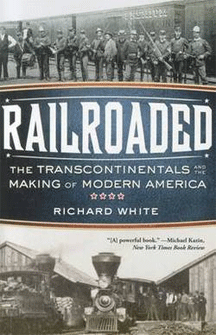By John P. McWilliams
To many Americans, the words “Transcontinental Railroad” evoke the famous Andrew J. Russell celebratory photograph of the joining of the Central Pacific and Union Pacific railroads at Promontory Point Utah in 1869. To fewer Americans, the words still evoke Matthew Josephson’s denunciation of the late nineteenth century “Robber Barons” and/or the attack on the Southern Pacific Railroad in Frank Norris’s novel The Octopus (Doubleday, 1901). Richard White is after different game. White’s narrative of the driving of the Golden Spike at Promontory Point ends with his first chapter, titled “Genesis.” Thereafter White’s multiple narratives focus on the intermittent building and recurrent failure of ten to twelve transcontinental railroads that traversed Canada, Mexico, and the United States between 1870 and 1910. Through extensive use of archives, especially personal letters, White builds a convincing case that the railroad magnates’ drive for personal wealth and power led to waste, wrangling, disorder, and sheer incompetence on a truly continental scale. Consequently, the infamous “Big Four” of the Central Pacific and Southern Pacific are less Robber Baron tycoons, ruthlessly squeezing farmers, ranchers, and miners of their every transportational penny, than they are bunglers whose skills were limited to amassing unsustainable corporate debt.
White shows exactly how the waste and bungling were achieved. Gifts to Congressmen brought federal land grants with mineral and timber rights. Bonds would, on occasion, be given to “friends of influence” or more commonly sold to them at less than par value. Government loans would then be negotiated, sometimes without interest for up to thirty years. Stock would be issued, then “hypothecated” as collateral for obtaining a new loan. Railroad executives often hustled their own stock. Interlocking directorates of prominent Boston, New York, and Washington families would hopefully sustain private funding while furthering collusion. A railroad would create an insider construction company that would overcharge for laying the track, thus lining the private pockets of executives, while creating a public need for a new loan.
Entrepreneur executives, who knew little about railroading, soon encountered skyrocketing costs, exasperating delays and paltry revenues, causing a need for still another loan or still another issue of bonds or stocks—in effect a nineteenth century Ponzi scheme. Because the “strikers” stalking the halls of Congress, who had lobbied for multiple companies, were proving to be unreliable, the transcontinental railroads established their own permanent Washington lobby offices. Financial figures in the newly customary Annual Reports could be made up when necessary. Railroads bought newspapers, issued free railroad passes, and granted discriminatory rates, as well as rebates, to large customers and to select friends of influence. Whether Republican or Democrat, a Congressional friend could best be secured by discovering who would be the likely first-time winner in a particular voting district, and then supporting him.
Many of these modes of operation have long been known. What is new is Richard White’s insistence on their ultimate failure. Although he accepts Joseph Schumpeter’s idea of the creative destruction of capitalism, White emphasizes destruction, not creativity. Short rail lines between productive rural communities and large cities were needed, but transcontinental railroads, however exciting their symbolic appeal, were not. Between 1873 and 1876, then again between 1893 and 1896, the transcontinental railroads contributed greatly to a national depression. Some of the railroad entrepreneurs became wealthy beyond measure, but many did not, and most of their railroads went into bankruptcy or receivership. The damage to the environment, as well as the human costs to laborers, families, the Chinese and the Indians, were scarcely reckoned at the time. The entrepreneurs who bossed the railroads were not fearsome titans of industry but ordinary if ambitious storekeepers whose notoriety came at an immense personal price in health and happiness.
Between the corrupting practices of nineteenth century railroads, and the corrupting practices of Wall Street between 2008 and 2011, White sustains interesting comparisons, sometimes explicit, sometimes implicit. Railroaded cannot be read in 2012 without uneasy memory of sub-prime mortgage bundles, of credit default swaps, and of the uses of the phrase “too big to fail.” White’s revisionism is dark in hue, but remains engaging because of his wonderfully caustic sense of humor: “In nineteenth-century politics, as much as now, the side with the best metaphors often wins;” “The value of a lie depended on the apparent rectitude and disinterestedness of the liar;” “While a reformer might be one railroad’s enemy, he could as a result become another railroad’s friend.” It may all happen yet again. If so let us hope that, next time, we can still summon such sustaining wit.
John P. McWilliams (ΦBK, Princeton University, 1962) is College Professor of Humanities at Middlebury College and a resident member of the Beta of Vermont chapter of Phi Beta Kappa.




